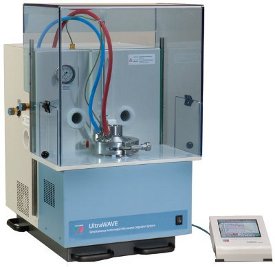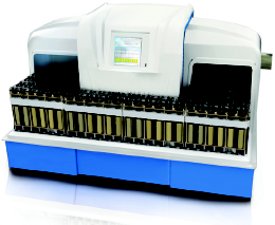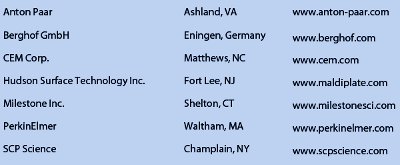Please see our Microwave Digestion System / Microwave Digester sections to find manufacturers that sell these products
Microwaves are used in conjunction with acid digestion to break down samples in preparation for elemental analysis by inductively coupled plasma/mass spectrometry (ICP/MS), inductively coupled plasma/atomic emission spectrometry (ICP/AES), or similar methods. The heat from the microwaves speeds up the chemical reaction of the acid with the sample, reducing the digestion time from hours to minutes.
Microwaves are an efficient heating method since they transmit the heat directly to the sample, rather than having to transmit the heat from a hot plate to the vessel to the sample. This direct method of heating also makes it highly controllable. Heating stops as soon as the microwaves are turned off, giving instant control over the process.
Microwave digestion is carried out on large soil, sludge, slurry, or oil samples for environmental and industrial applications. It is used for preparing steel samples to determine the content levels of elements such as boron or silicon. It is also widely used for smaller-scale food and beverage samples to detect trace mineral nutrients and trace elements for health and safety purposes. In recent years, the demand has grown for trace element testing of pharmaceutical excipients, intermediates, and final products. Other typical applications include polymers, textiles, and botanical samples.
Regulatory requirements
U.S. EPA Method 3015A defines the regulatory standards for the microwave-assisted acid digestion of aqueous samples and extracts. Method 3051A relates to sediments, sludges, soils, and oils, and Method 3052 to siliceous and organically based matrices.
U.S. Pharmacopeia Draft Method 232 specifies the limitation of elemental impurities in drug products. USP Draft Method 233 features microwave digestion as a sample preparation technique for determining elemental impurities.
Closed vessel microwave digestion proceeds by the following stages:
- Load the sample into the reaction vessel
- Add reagents and catalysts
- Seal the vessel and load into the chamber
- Set the program
- Heat the vessel with microwaves, according to the program
- Monitor temperature and pressure during the reaction
- Vent the system
- Cool down the vessel
- Remove the vessel from the chamber and the sample from the vessel.
For open vessel microwave digestion, the sample rack is lowered into a pre-pressurized chamber that acts as a virtual lid. This significantly reduces operator handling requirements. Open vessel digestion is particularly suited to high-throughput labs that have a variety of sample types.
Your choice of digestor will depend mainly on the type and range of sample matrix you will be handling and the level of throughput you require. For example, Milestone (www.milestonesci.com) offers a range of digestors. For a small number of samples, particularly for a single matrix, the company recommends the closed vessel Ethos EZ.
For labs with high workloads and challenging and multiple sample types, Milestone recommends the UltraCLAVE or benchtop UltraWAVE, both of which use Milestone Single Reaction Chamber (SCR) technology. Samples are placed simultaneously into the digestion chamber. Identical conditions are used for all samples, and any combination of sample types can be safely digested in the same run, leading to significant time and labor savings.
Power output, temperature, and pressure range
In general, the higher the temperature, the quicker the reaction. Higher microwave power delivers high temperatures faster, although this is not suitable for every reaction.
Multiwave PRO from Anton Paar (www.anton-paar.com) has two magnetrons of 850 W each to ensure a consistent delivery of 1500 W over its lifetime. Unpulsed microwave power over the whole range ensures precise control of critical reactions.
Microwave digestion usually takes place in closed vessels under pressures up to 2000 psi. Open vessel digestion methods can reach pressures of over 2500 psi at up to 300 °C.
The Multiwave ECO from Anton Paar allows for longer temperature ramping for reactive organic samples to ensure moderate reaction regimes. The pressure stability of the pressure control valve in the Multiwave ECO guarantees stable temperatures over the entire reaction time up to 250 °C.
The vessel material determines the limits of temperature and pressure. Most reaction vessels are made of fluoropolymer, which is inert and stable at high temperatures. High-quality quartz vessels are often used for ultratrace detection, although most fluoropolymers are of high enough quality to allow for ultratrace detection.
The Milestone NOVA-8 rotor holds 8 TFM™ fluoropolymer vessels with a volume of 75 mL. It is designed to work at sustained high temperatures up to 300 °C, allowing for complete digestion of the most difficult matrices, such as ceramics and refractory materials.
Vessel capacity and samples per run
The capacity of vessels is determined according to the type of sample and sample composition. Vessels are housed in turntables or racks. Manufacturers supply different vessels and turntables for different analytical problems.
The Discover SP-D from CEM Corp. (www.cem.com) has pressurized vessels in 10-, 35-, or 80-mL capacity with easy snap-on caps.
The Titan MPS™ from PerkinElmer (www.perkinelmer.com) makes it easy to change from one vessel type to another. The eight-vessel turntable has 100-mL capacity, and 75-mL capacity for the 16-vessel turntable. They fit into the turntable individually without the need for a heavy rotor.
Milestone offers a selection of vessels in carousels holding from 8 to 77 vessels. Some are designed for high pressure, some for high temperature, and some for high throughput. The UltraCLAVE has an optional rack that holds 77 12-mL vials, a size suitable for clinical microscampling applications.
Hudson Surface Technology’s (www.maldiplate.com) Rapid Enzyme Digestion System is a high-capacity biological sample digestion and denaturization tool, designed to process large numbers of small samples efficiently.
Reaction time, venting, and cooling systems
The reaction time will vary according to the sample matrix and size. Typical digestion times are on the order of 8–10 min. However, you must also factor in the time to prepare the reaction vessel, venting time, and cool-down time. For high-throughput labs, consider also how long it takes to prepare the vessel and instrument for subsequent runs with new samples.
The Discover SP-D from CEM quotes a sample digestion of just 10 min, including cool-down for the following samples: 0.3 g motor oil, 0.5 g bovine muscle tissue, 0.25 g peanut butter, or 0.5 g plastic. The bovine muscle example includes 4 min of ramp-up time and 3 min of hold time at a temperature of 200 °C, pressure of 300 psi, and microwave power of 300 W.
The PerkinElmer Titan MPS system’s gas containment manifold captures and removes any gases that vent during digestion. The chamber continually evacuates during oven operation, keeping the enclosure free of gas or acidic vapors
 Figure 1 – The UltraWAVE from Milestone uses Single Reaction Chamber (SRC) technology. The UltraWAVE is water cooled and can achieve a cooling of 270 °C to 80 °C in 11 min.
Figure 1 – The UltraWAVE from Milestone uses Single Reaction Chamber (SRC) technology. The UltraWAVE is water cooled and can achieve a cooling of 270 °C to 80 °C in 11 min.Anton Paar’s Multiwave ECO’s air cooling system provides extremely fast cooling of the vessels back to 70 °C in 15 min. Milestone’s UltraWAVE (Figure 1) is water cooled and can achieve a cooling of 270 °C to 80 °C in 11 min.
Sensors and safety features
It is vital to constantly monitor the temperature and pressure of each sample vessel throughout the reaction process. Different samples and reagents have different microwave absorbency profiles, and overheating can cause reactions to go out of control very quickly. An advantage of microwave energy is that it can instantly be adapted to control the reaction, or can be completely turned off in an emergency.
The reaction temperature in the 16MF100 rotor from Anton Paar is controlled by two sensors: an immersing temperature probe inside a reference vessel and an IR sensor underneath the oven cavity, which measures each vessel through ports in the rotor base.
 Figure 2 – The speedwave four from Berghof features a swing top with electronic lid blocking for the highest level of safety and ease of handling.
Figure 2 – The speedwave four from Berghof features a swing top with electronic lid blocking for the highest level of safety and ease of handling.The speedwave®four from Berghof (www.berghof.com) (Figure 2) has a patented optical sensor to measure the temperature and pressure of each sample. Temperature is monitored by IR radiation. Pressure is determined by measuring the change in wavelength of polarized light as the pressure changes. The sample material never comes into contact with sensors or probes. Complicated connection of sensors to sample vessels is totally eliminated.
The NovaWAVE from SCP Science (www. scpscience.com) (Figure 3) features safety caps positioned above each vessel to safeguard against vessel over-pressurization. Vessels will vent automatically if required. In the event of a vessel breakage, power will shut down automatically in milliseconds.
Programmable control and reporting methods
Every sample, reagent, catalyst, and acid has its own heating profile, and different materials have different levels of absorbency to microwave radiation. Therefore, microwave digestors need to be programmed for each reaction. Check whether the digestor can be programmed individually for each sample vessel, or whether one heating profile will apply to all the samples.
 Figure 3 – The NovaWAVE from SCP Science is a fully automated sample digestion tunnel. The Model FA provides unattended, automatic processing of up to 14 racks, totaling 168 samples.
Figure 3 – The NovaWAVE from SCP Science is a fully automated sample digestion tunnel. The Model FA provides unattended, automatic processing of up to 14 racks, totaling 168 samples.Intelligent software can have a high impact on usability. For example, the ETHOS EZ from Milestone has a multivariable microwave control that automatically regulates the microwave power. The total power is defined in the method and the temperature is monitored 20 times per sec. A PID feedback mechanism constantly makes small adjustments to the power so that the digestion temperature is kept to the required profile.
Reporting methods may be important for QA/ QC purposes. The NovaWAVE (SCP Science) temperature profile graph reports may be viewed individually by cycle, by rack, or by tube.
Consider also how easy it is to run preprogrammed methods and to monitor the system in the lab. The speedwave two from Berghof has an extremely easy-to-use control system, requiring just two steps to run a program. The Multiwave PRO from Anton Paar has a large color touchscreen that is easy to read from a distance.
Recent developments—automation
Some systems have recently introduced automation to microwave digestion. This is particularly suited to high-volume labs since it increases throughput. It also assists in safety and precision by minimizing operator handling requirements.
The NovaWAVE from SCP Science is a fully automated sample digestion tunnel that can process multiple sample trays at once. One tray enters the tunnel for digestion as the previous tray moves to the cooling station. After cooling, the rack moves to the autoventing station. Vessels are automatically vented when they reach the temperature defined in the method. The company estimates that the NovaWAVE can prepare 275 samples in 8 hr. Furthermore, 168 samples can be loaded and digested overnight, ready for further processing in the morning.
The new Milestone vessel handling module, TWISTER, automatically opens and closes vessels, eliminating bottlenecks associated with the handling multiple digestion vessels and increasing operator safety, since the operator is not exposed to acid vapors during vessel opening.
Other purchasing considerations
What is the construction material of the instrument?
Table 1 – Liquid handling system manufacturers 
Manufacturing materials will help to prevent corrosion and will affect the lifetime of the instrument. Berghof’s speedwave four has stainless steel housing and PFA coating to provide effective protection against corrosion. Titan MPS from PerkinElmer is a PFA-coated stainless steel oven chamber.
What accessories are available?
Multiwave PRO from Anton Paar has a wide range of accessories to allow digestion, parallel method development, multigram synthesis, leaching, oxygen combustion, solvent extraction, drying, evaporation, and UV digestion with one single system.
How easy is it to clean the vessels before reuse?
The vessels in the speedwave four from Berghof have no dead volume and are therefore easier to clean.
A list of manufacturers of microwave digestion systems is given in Table 1.
Please see our Microwave Digestion System / Microwave Digester sections to find manufacturers that sell these products
Katriona Scoffin, B.Sc., is a freelance science writer; e-mail: [email protected]